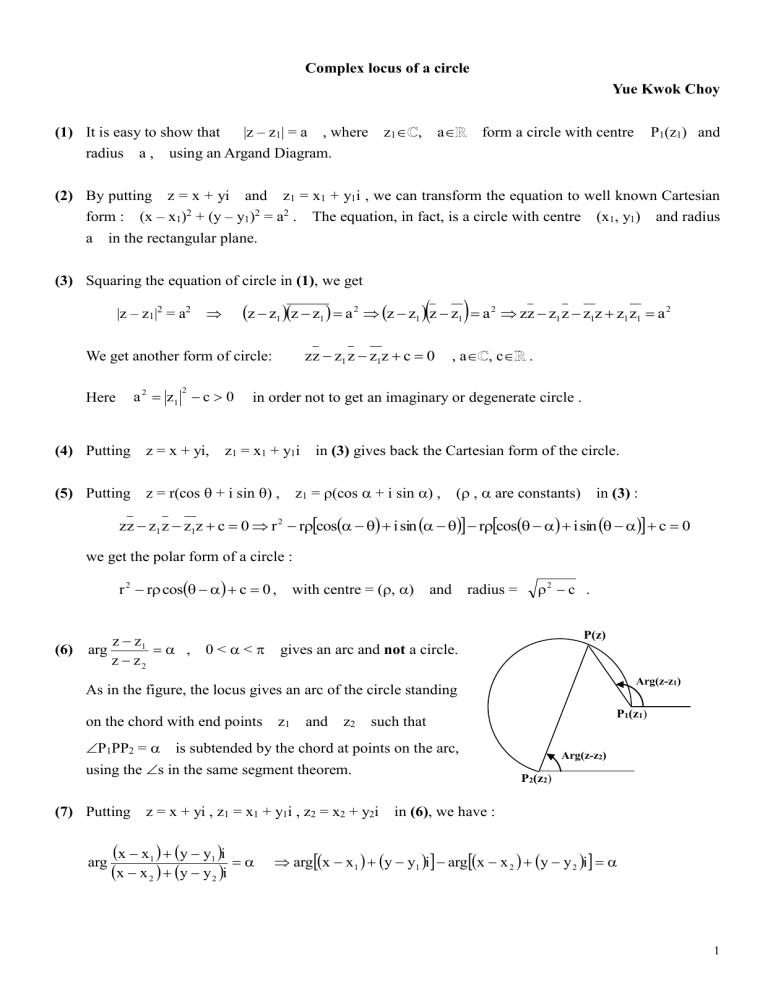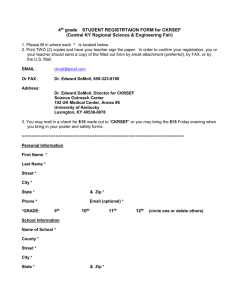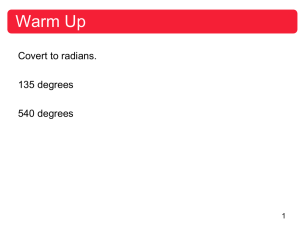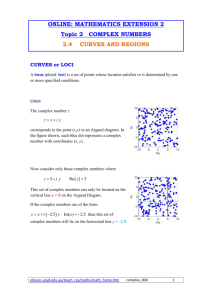Complex locus of a circle , doc

Complex locus of a circle
Yue Kwok Choy
(1) It is easy to show that |z – z
1
| = a , where z
1
, a
form a circle with centre P
1
(z
1
) and radius a , using an Argand Diagram.
(2) By putting z = x + yi and z
1
= x
1
+ y
1 i , we can transform the equation to well known Cartesian form : (x – x
1
)
2
+ (y – y
1
)
2
= a
2
. The equation, in fact, is a circle with centre (x
1
, y
1
) and radius a in the rectangular plane.
(3) Squaring the equation of circle in (1) , we get
|z – z
1
|
2
= a
2
z
z
1
z
z
1
a
2
z
z
1
a
2 z z
z
1 z
z
1 z
z
1 z
1
a
2
We get another form of circle: z z
z
1 z
z
1 z
c
0 , a
, c
.
Here a
2 z
1
2 c
0 in order not to get an imaginary or degenerate circle .
(4) Putting z = x + yi, z
1
= x
1
+ y
1 i in (3) gives back the Cartesian form of the circle.
(5) Putting z = r(cos
+ i sin
) , z
1
=
(cos
+ i sin
) , (
,
are constants) in (3) : z z
z
1 z
z
1 z
c
0
r
2 r
cos
i sin
r
cos
i sin
c
0 we get the polar form of a circle : r
2 r
cos
c
0 , with centre = (
,
) and radius =
2 c .
(6) arg z z
z z
2
1
, 0 <
<
gives an arc and not a circle.
P(z)
Arg(z-z
1
)
As in the figure, the locus gives an arc of the circle standing
P
1
(z
1
) on the chord with end points z
1
and z
2
such that
P
1
PP
2
=
is subtended by the chord at points on the arc, using the
s in the same segment theorem.
P
2
(z
2
)
Arg(z-z
2
)
(7) Putting z = x + yi , z
1
= x
1
+ y
1 i , z
2
= x
2
+ y
2 i in (6) , we have : arg
x x
x
1 x
2
y y
y
1 y
2 i
i
arg
x
x
y
i
1 y
1
arg
x
x
y
y
i
2 2
1
tan
1
y x
y x
1
1
tan
1
y x
y x
2
2
* *
t a n
t a n
1
y x
y
1 x
1
t a n
1
y x
y
2 x
2
t a n
y
y
1
1 x
y x
1 x
y
1 x
y x y x
y x y x
2
2
2
tan
1 2
x
x
2
y
y
1
x
x
1
y
y
2
tan
x
x
1
x
x
2
y
y
1
y
y
2
(8) The last equation in (7) is a homogenous equation of degree 2 , also
(a) coeff. of x
2
–term = coeff. of y
2
term and
(b) there is no xy-term,
It therefore gives a complete circle and not an arc.
* *
The "problematic" step in (7) marked by " " changes the arc into a circle .
(9) The locus of P in (7) represents :
(a) when
= 0 , the whole line P
1
P
2
with the line segment P
1
P
2
removed.
(b) when
=
, the line segment P
1
P
2
.
(c) when 0 <
<
, an arc of a circle, terminating at P
1
and P
2
(and excluding these points)
(d) when
=
/2 , a semicircle and the supplementary semicircle is given by
= 3
/2 .
(10) arg z z
z z
2
1
or
+
, 0 <
<
gives a complete circle with P
1
and P
2
removed.
You may investigate the following loci :
(a)
(b) arg arg z z
z z
2
1 z z
z z
2
1
or
–
, 0 <
<
.
, 0 <
<
.
(11) z
z
1 z
z
2
k where z
1
, z
2
, k > 0 , k
1 gives a circle (excluding points P
1
(z
1
), P
2
(z
2
) )
Note : When k = 1, the locus is the perpendicular bisector of the line joining P
1
(z
1
) and P
2
(z
2
) .
Proof : z
z
1
2 k
2 z
z
2
2 z
z
1
z
z
1
k
2
z
z
2
z
z
2
z
z
1
z
1
k
2
z
z
2
z
z
2
z z
z
1 z
z
1 z
z
1
2 k
2 z
z
z
2 z
z
2 z
z
2
2
1
k
2
z z
z
1
k
2 z
2
z
z
1
k
2 z
2
z
z
1
2 k
2 z
2
2
0
2
z z
z
1
1
k
2 k
2 z
2
z
z
1
1
k
2 k
2 z
2
z
z
1
2 k
2
1
k
2 z
2
2
0
z z
z
1
1
k
2 k
2 z
2
z
z
1
1
k
2 k
2 z
2
z
z
1
2 k
2 z
2
1
k
2
2
0
Comparing this with that given in (3), we get a circle with centre z
1
1
k
2 z
2 k
2
and radius a, where a
2 z
1
1
k
2 k
2 z
2
2
z
1
2 k
2 z
2
1
k
2
2
a
k z
1
1
k z
2
2
on simplification (exercise)
(12) z z
z
1
z
2
k
z
z
1
k z
z
2 and if we take P(z) a variable point and P
1
(z
1
) and P
2
(z
2
) , we have P
1
P = k P
2
P . This then reduces to a well-known geometry problem :
The Circle of Apollonius : Given two fixed points P
1
and P
2
, the locus of point P such that the ratio of P
1
P to P
2
P is constant , k, is a circle.
The Circle of Apollonius is not discussed here. Interested readers may consult web-sites such as: http://jwilson.coe.uga.edu/emt725/Apollonius/Cir.html
If we know that the locus is a circle, then finding the centre and radius is easier.
As in the diagram, C is the centre and AB is the diameter of the circle.
Then A and B divide P
1
P
2
internally and externally :
P
1
A : AP
2
= k : 1
P
1
B : BP
2
= –k : 1
By section formula:
A represents z
1
1
kz
2 k
B represents z
1
1
kz
2 k
P
1
(z
1
)
|z-z
2
|
A
P(z)
|z-z
1
|
P
2
(z
2
)
C
The centre of the circle represents
1
2 z
1
1
kz
2 k
z
1
1
kz
2 k
z
1
1
k
2 k
2 z
2
B and the radius = CA
z
1
1
kz
2 k
z
1
1
k
2 z
2 k
2
k z
1
1
k z
2
2
.
3









